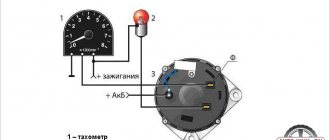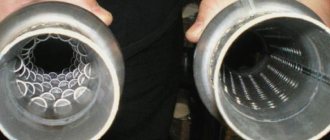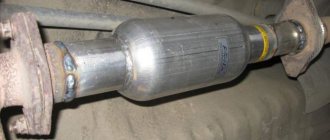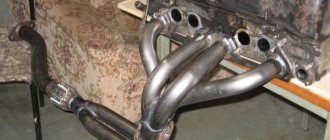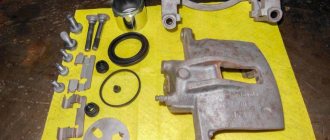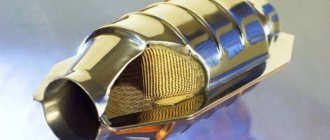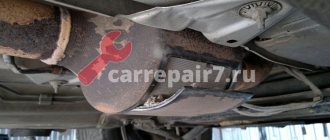08.11.2019
Modern cars are equipped with increasingly advanced exhaust systems. This is partly due to the fight for environmental safety, and partly to the desire to reduce noise while driving. To achieve minimal noise, they often resort to a method such as installing a flame arrester instead of a resonator.
The elements of the system operate under conditions of high temperatures and aggressive influence of the external environment, so they often become unusable over time. There is a trend on the market towards the unification of all exhaust system spare parts, so you can easily select a part for your car model, this also applies to flame arresters and resonators. They are available for quick installation with a minimum amount of cutting or welding.
However, it is recommended not to replace the resonator with a flame arrester yourself, but to contact a specialist.
Flame arrestor and resonator: the difference
Flame arrestor, stronger, turbine are types of resonators that differ in design and operating principle. For example, a flame arrester is a resonator made of stainless steel with a retaining washer installed inside, or in some cases without it. Flame arrestors are usually installed instead of catalysts. Instead of a collector catalyst, it is advisable to install a shortened flame arrester without a retaining washer. Such flame arresters are most often installed during tuning of exhaust systems or on powerful turbocharged cars.
Collector flame arrester:
Flame arrestor without retaining washer:
Flame arrestor with retaining washer:
Strongers (turbines) are designed to reduce fluctuations in exhaust gases in the exhaust system, but they dampen the sound less than other options. The simplest resonators are divided into two types according to the method of damping resonance: direct-flow ones dampen sound using a perforated pipe, around which a noise-absorbing pad is located, and a more complex design also includes a chamber for creating pressure and vacuum.
Stronger:
Stronger, rear view:
Is it possible to install a flame arrester instead of a resonator and how will the sound change? As a rule, it is installed instead of a catalyst, although this causes increased emissions. The catalyst provides a different speed of gas movement and reflects sound waves and impulses differently. All other systems of the car are tied to this. If you install another device, the parameters of efficiency, fuel consumption, and engine life may change. This solution does not change the engine power much; at most, an increase of 1-2% will be observed. But the engine will be very quiet, and it’s a pleasure to drive such a car.
If you still plan to make a change, then this must be done by the hands of experienced auto mechanics.
Myth and reality
According to experts, on some cars oil consumption increases after the catalyst is removed - the car was initially designed in such a way that the engine runs against the pressure exerted by the catalyst. As soon as it is removed, the pressure disappears and the oil flows more freely, but certainly not in liters, as some service technicians say. And if you don’t load the engine and spin at high speeds, you won’t notice the difference.
What should a flame arrester be like?
As for the flame arrester body, it must consist of two layers - then the outer one will dampen the vibrations of the inner one. If this condition is not met, then one housing will rattle when a sound wave hits it. Also, the outer material must be resistant to corrosion, otherwise damage due to changes in temperature, humidity and salt on the roads is inevitable. Optimally - heat-resistant stainless steel. Corrosion usually does not develop on the inner layer, so the choice of good materials is not critical.
Another important factor when choosing is the volume of the flame arrester, it directly affects how the muffler and resonating device will work. If the volume is not enough, then an extraneous sound will occur when you press the gas, and the sound coming out of the muffler will also be stronger.
Air springs in springs: a budget option for do-it-yourself air suspension
- Mazda 3;
- Hyundai Elantra;
- Chevrolet Lacetti;
- Ford Focus;
- Renault Megane;
- Toyota Prado 120;
- Hyundai Solaris;
- Opel Astra;
- Niva Chevrolet;
- Kia Rio, etc.
The use of deception should not be ignored. You already know about the consequences of such a rash decision.
Advantages and disadvantages
In conclusion, I propose to look at the pros and cons, that is, at the possible negative and positive consequences if you replace the standard catalyst with a not quite standard flame arrester.
Resonator instead of catalyst
There is such a type of tuning as installing a resonator without a catalyst. This is a fairly common method of repair in Russia for any problems arising with the catalyst, you can easily verify this by reading automobile forums. Removing the catalyst is a measure that violates environmental standards, but is attractive due to its low cost. Installing a replacement will cost several times less than buying a new spare part.
Most often, the catalytic converter is replaced with a stronger or flame arrester, since a conventional hollow resonator under the catalyst does not tolerate proximity to the engine.
Occasionally, a new device is installed with several catalysts at once, implanting it instead of the last one. Thus, passing all the way from the engine, the exhaust loses most of the energy and temperature and does not damage the resonator with the catalyst.
Resonators with vacuum:
Flaws
Of course, there are some downsides. When installing it, some motors begin to “choke.” The flame arrester creates too high a pressure, due to which if the engine operates at high speeds, the dynamics deteriorate compared to a well-functioning catalyst.
So it is not at all necessary to install a flame arrester instead of a catalyst. Moreover, a high-quality element costs about 8,000 - 10,000 rubles (this does not include installation). Its service life is about 5 years.
The catalytic converter in a car serves to reduce the toxicity of exhaust gases from the engine, but in Russian conditions, the exhaust system element often becomes clogged with slag and fails.
New catalysts are expensive, and many car owners are trying to get rid of the catalytic converter (CN) and install a “dummy” instead. Whether this element needs to be cut out, and what happens after removing the catalyst, we will look at in this article.
Possible reasons for replacing the resonator with a flame arrester
Car owners periodically face the following problems:
- Mechanical damage caused by a blow to the body or strong vibrations due to damaged rubber suspensions.
- The internal structure of the device has collapsed.
- The housing or other structural components have burnt out.
- The sound changes - with minor leaks in tightness, cutting sounds appear, with serious ones - a characteristic roar.
- The smell of exhaust gases appears in the cabin, and they also come out from under the bottom of the car.
- A rattling noise is heard from inside the case.
In all these situations, the solution may be to replace the resonator, and at this moment the owner is faced with the question - resonator or flame arrester, which is better? It is necessary to clearly understand the differences between these devices, take into account the design features of the exhaust system of a particular car, as well as the experience of replacement on similar cars.
Why do they replace?
I won’t tell anyone a secret if I say that the decision to replace the catalyst with a flame arrester is largely due to the economic component. That is, the car owner simply wants to save money.
Just look at the cost of this element. If we take into account even domestic cars, the price tag will look impressive. Now imagine that your VAZ has already covered about 200-300 thousand kilometers. And here the need arises to change the catalyst. Such a purchase will cost 50-70 thousand rubles. Agree, the amount is more than serious. And compare it with the cost of a flame arrester, the price of which is several times less. Some even make it with their own hands from a piece of pipe, making many holes in it. Then the price will be completely zero.
If you decide to install such a design for yourself, do not forget about the mandatory equipment of a stronger with blende. Decoy, catalyst emulator, lambda decoy. Call it what you want. This will not change the essence.
The lambda decoy serves to correct the incoming signal from the oxygen sensor to the electronic control unit of your car. Moreover, it is necessary to install such a device if a flame arrester is installed in place of the catalyst.
Without doing this, the ECU will begin to perceive the operation of the exhaust system as problematic, and the emergency mode of operation of the internal combustion engine will begin to constantly turn on. This will result in a decrease in engine life and an increase in fuel consumption.
Similar designs, made from stronger and blende, can be installed on any car:
Why replace the catalyst with a flame arrester?
There are a number of reasons for this:
- Increasing car power. The flame arrester returns to the machine the power that was previously consumed by the catalyst, and also easily allows previously trapped gases to pass through. As a result, the car moves easier.
- Saving. There is no need to buy an expensive catalyst for a specific car model. The difference in price is noticeable - on average, more than 4 times.
- The ability to fill with gasoline with a lower octane number - therefore cheaper.
In addition, the load on the engine is reduced and it lasts an order of magnitude longer.
Another interesting option is when removing the particulate filter, move the standard (factory) resonator to the place of the particulate filter (may not be on all cars). The process involves cutting out the factory optional muffler, after which it is inserted directly into the forward flow using a 4-piece connection. This option is not too different from the first, except for eliminating one of the thickenings under the car bottom.
To make an appointment to replace the resonator, call us by phone or use the form on the website. The car service is located in St. Petersburg, on Kantemirovskaya Street, 39D. We guarantee high-quality diagnostics and service at reasonable prices.
avtoexperts.ru
The struggle of automobile engineers for the environment has led to the appearance in the design of cars of units that are not used for movement, but reduce the level of air pollution. Among them is the catalytic converter, which is often simply called a catalyst. A metal can with a ceramic honeycomb system inside “afterburns” exhaust gases and reduces the harmfulness of car exhaust. Alas, this part is not eternal, sooner or later (in Russian realities, rather sooner) the catalyst becomes clogged, its honeycombs are destroyed, and it not only ceases to perform its functions, but also prevents the engine from working. The question of replacement arises.
Catalyst
Pros and cons of flame arresters
Purely theoretically, it is possible to replace a faulty catalyst with a new one, but such a replacement will cost a lot of money. Catalytic converters are very expensive - they can cost up to a quarter of the market value of a used car. But there are models that have several catalysts installed, and in case of breakdown, each one needs to be replaced. Naturally, few people resort to such expenses; the majority of car owners prefer a more budget-friendly solution to the problem - installing a flame arrester instead of a catalyst.
The advantages of this approach are obvious:
1. Lower price. Replacing a catalyst with a flame arrester can cost 5-10 times less than buying a new cat. There is no need for comments here.
2. Slight increase in engine power and reduction in fuel consumption . The flame arrester creates less resistance to exhaust gases than the catalyst; the engine with it “breathes” better, which means it increases power. True, the increase, like fuel savings, is not very large - about 5-10%. Most drivers won't feel it. It is not worth specifically removing the catalyst for the sake of increasing power, but for those who nevertheless decide on this procedure, improving engine performance is a small bonus.
3. Reduced requirements for fuel quality. The catalyst reacts most sharply to “scorched” gasoline and often fails because of it. The flame arrester does not have this. This does not mean that after replacement you can refuel at dubious gas stations, but you won’t have to worry about an expensive and fragile part when using unfamiliar gas stations.
Catalyst device
There are also disadvantages:
1. First of all, ecology . If you are proud that your car pollutes little of the environment, then after replacing the catalyst with a flame arrester, you need to stop doing this, because your car will no longer have the former Euro-4 or Euro-5. In Europe, by the way, they can be punished for this, but in Russia the situation is simpler.
2. The need to flash the ECU. The electronic control system is designed to use a catalyst and without it it will start to go crazy. When using a flame arrester, at a minimum, you need to install decoys on the oxygen sensors, and in the best case, reflash the engine .
3. Reducing the life of the exhaust system. Even a good flame arrester does a worse job of reducing the exhaust temperature than a catalyst, so the risk that the muffler will burn out increases . On the other hand, with the money that a flame arrester will save, you can change more than one muffler.
Step-by-step process for replacing the catalyst
The benefits of replacing the catalyst are obvious, but we wouldn't say it's that easy. As a famous character from “The Lord of the Rings” would say, you can’t just replace the catalyst. It’s good if you managed to find a flame arrester on sale that can be installed in a standard location for your car model. But this is not always possible; most often you have to deal with universal flame arresters, which need to be adjusted to the location, or even make a flame arrester yourself. People without experience with an angle grinder and welding should not undertake replacement work.
In the photo: destroyed catalyst
Step 1. Removing the catalyst . There are main catalysts (built into the exhaust tract under the bottom of the car) and manifold catalysts, located directly in the exhaust manifold. The first ones are easier to remove, especially if the design involves fastening with bolts and they were able to be unscrewed (given the location and operating conditions of the catalyst, this is not always possible). If there are no bolts or they are tightly stuck, a grinder is used. The latter require dismantling the exhaust manifold, which increases the complexity of the process.
Removing the catalyst
Step 2. Selecting a flame arrester. The supply on the flame arrester market is sufficient; you can consider parts that are both cheaper and of better quality. The products considered more or less decent are “Walker”, “Bozal”, “Ernst”, “Tesh” and the Russian “MG-RACE”, but, in general, the main thing is that the flame arrester is two-layer , the brand is not so important.
Flame arrestor MG-RACE 40133U
However, the flame arrester is such a simple unit that you can make it yourself. Cut the body of the catalyst, knock out all the filling from it, and instead insert a piece of perforated pipe, line the inside of the body with heat-resistant, sound-absorbing material (for example, basalt fiber), weld it and the flame arrester is ready. In terms of money, such a unit will turn out to be very cheap, but only those who know how to use a welding machine should take on making their own flame arrester. As practice shows, the most common failure of flame arresters is a burst weld.
Homemade flame arrester - inside there is a “Street” mesh
Step 3. Installing a flame arrester. If we are not talking about products precisely designed for standard locations, then to install flame arresters you have to use a combination of bolts, welding and ingenuity . It’s not that it’s very difficult, but you have to measure and adjust the dimensions, think through the location, especially when it comes to collector flame arresters. In addition, no manufacturer describes such a procedure in official reference materials, so information must be sought in additional sources.
In the photo: the flame arrester is inserted into the catalyst body and welded
Finished look
Step 4. Electronics correction. In order for a car to work correctly with a flame arrester, you need to make a fake or emulator for the second lambda probe, or completely reflash the engine. The decoy is like a neutralizer in miniature, it “filters” a piece of exhaust that enters the sensor, showing that no matter how good everything is, the emulator simply transmits to the engine the values that it expects from it, without taking real measurements. Cheats and emulators may not work, but good alternative firmware almost always solves problems after installing a flame arrester.
Mechanical snag for lambda probe
Price issue
How expensive is it to replace a catalyst with a flame arrester? The units themselves are relatively inexpensive - from 1.5 to 3 thousand rubles, depending on the brand and design. Making a flame arrester yourself is unlikely to save money, but such a replacement will probably be better suited to a specific car model than something universal. This is especially true for cars with powerful engines.
Prices for replacement services depend on the region and make of the car. In Moscow, on average, they ask for 6-8 thousand rubles for such a service (although the price range is very wide). Separately, you will need to pay extra for installing the decoy or flashing it. In the regions, the standard price for such a service is 3.5-5 thousand rubles.
Original catalysts cost from 50 to 100 thousand rubles, so if there is a problem with them, it is very reasonable to pay attention to flame arresters (this can be 10 times cheaper!). The savings are obvious, and the replacement can be done yourself or in most services, the main thing is not to forget to reflash the engine later.
Preliminary nuances
Let's start with the simple concept of a catalyst, which for some reason they want to replace with their own hands or the hands of a craftsman with a flame arrester. The catalyst is a device that is part of the exhaust system. It serves to purify gases produced during fuel combustion from all kinds of impurities.
But if this device breaks down or becomes dirty, returning it to its original level of performance is not so easy. In fact, car owners make one of 2 decisions. In the first case, they buy a new part and install it in place of the old one. The second option is to replace the catalyst with a device called a flame arrester. He's a strongman. At the same time, there is a lot of controversy and talk around the second method. Motorists sometimes do not understand why they should do this, what such modification will do and whether it will worsen the performance of the car.
Car enthusiasts are divided into 2 camps. Some argue that installing a stronger is an excellent tuning solution. Others are confident that such modernization will only cause harm.
But how dangerous would it actually be to remove the catalyst? And if this is harmful, then why do service stations actively offer this service in Yekaterinburg, St. Petersburg, cities such as Moscow, Voronezh, Volgograd and other parts of the country? And the price isn't that bad.
It's all about the myths that have formed around flame arresters. They look like this:
- the motor begins to quickly fail;
- the muffler breaks down;
- the engine is very noisy;
- exhaust gases become more dangerous in their composition;
- great harm is caused to nature;
- in the cabin you can be poisoned by the exhaust;
- the engine consumes fuel in huge quantities;
- motor life is reduced significantly;
- the exhaust system lasts quite a bit, etc.
But it was not in vain that I focused on the fact that these are myths. Most of them are very far from the truth.
Fuel consumption after catalyst removal
Many car owners often ask the question: can fuel consumption increase after removing the catalyst? If the catalytic converter was simply cut out, the lambda probe installed after the catalyst insert will signal an error and the ECU will put the fuel system into emergency mode:
- the engine will lose power;
- fuel consumption will increase.
But car repair workers have learned to cheat the system - they reflash the control unit and remove the second lambda probe from the circuit. The electronics “believes” that there is no second sensor in the system, so error information does not appear, and the internal combustion engine operates normally. With the “trick”, fuel consumption after removing the catalyst is almost the same as with a catalytic converter, the only difference is that the emission of toxic substances into the atmosphere with the removed CN increases.
What will happen to a car without a catalyst?
The obvious fact is that removing the catalyst can be harmful to the environment. However, at the same time, you can achieve some increase in vehicle power, reduce fuel consumption and get rid of regular malfunction alerts. When you remove a faulty catalyst in your car, moments of traction sagging will be recorded much less frequently and problems with starting the engine will no longer arise.
It should also be understood that a clogged or melted catalyst will contribute to the return of exhaust gases back into the combustion chamber. In this case, conditions are created for the required flow of the combustible mixture to be disrupted, therefore, it loses its efficiency, which negatively affects the operation of the engine as a whole.
Firmware for EURO2 and snag – what does this mean?
As I wrote above, the second oxygen sensor (lower lambda) controls harmful emissions. Their number is now strictly regulated by European standards, which are called “EURO”; I will not talk about EURO “0-1” now; we are interested in the second generation.
So, what is EURO2 ? It was introduced a long time ago, namely in 1996. AT that time, the cars received an innovative system, namely a catalyst. As we all know, over time it can become clogged, and the fuel then was not the same as now, it had a lot of sulfur, which contributed to the honeycombs clogging much faster, and as you and I know, the car began to choke itself. Then the engineers installed an oxygen sensor, there was only one, and it was needed to capture CO2 in the chamber in front of the catalytic converter.
If the CO2 level increased, this indirectly indicated that the catalyst was clogged (that is, a backpressure effect was manifested); the sensor sent this information to the ECU and the ignition was adjusted, namely, a decrease in the supply of the fuel mixture. Thus, the power dropped significantly, the car did not drive and the owner “willy-nilly” had to go to a service station and change this spare part.
BUT, as you and I know, the price tag is, to put it mildly, HIGH, so many owners simply removed these honeycombs and the POWER RESTORED!
But how? YES, everything is simple, the CO2 level in the chamber in front of the neutralizer dropped significantly, the oxygen sensor recorded this (that everything is in order) and the car drove cheerfully and without constraint. This suited everyone, BUT NOT ECOLOGISTS! Therefore, they introduced the EURO3 standard (now the EURO5 standard already exists). What has changed is that a second oxygen sensor (lower lambda) just appeared behind the catalyst. The principle of operation here is this : the first lambda (before the filter) records the level of harmful substances, the second (after it) should record a much lower level, because the harmful substances have decomposed.
Smokes after removing catalyst
The catalyst is replaced if it fails and prevents the engine from operating normally. Typically, increased smoke is observed on cars with a faulty converter installed, and after removing the CN, the smoke disappears. However, car owners often complain that the car smokes even after removing the catalyst. There may be several reasons for this phenomenon:
- the firmware has not been re-flashed, and the “fake” has not been installed after removing the CN;
- there is a malfunction in the ECM (one of the sensors does not work), there are problems with the control unit itself;
- piston rings stuck;
- The ignition timing is not adjusted (it is set too late).
If black smoke comes out of the muffler pipe, this means that the fuel mixture is rich and there is excessive fuel consumption. As a rule, clouds of black smoke fly out of the chimney when you sharply press the gas pedal; if you unscrew the spark plugs, they will be covered in black deposits.
In modern systems, the ignition timing is adjusted using diagnostic equipment - laptops, car scanners. The cause of excess fuel consumption and the appearance of black smoke from the muffler may be sensor failure:
- air flow;
- absolute pressure;
- camshaft position.
If unstable engine operation is accompanied by bluish smoke from the muffler, the malfunction is not related to the fuel system and muffler, the cause of the increased smoke should be sought in the piston group:
- overheated or worn piston rings;
- the ring partitions on the pistons burst;
- The valve stem seals need to be replaced.
How much does it cost to change
The cost of the component itself is from 1 to 20 thousand rubles, depending on the manufacturer and type. Replacing a broken catalyst costs on average from 6 to 15 thousand rubles - depending on the type of element, the need for ECU firmware, and installation location.
Of course, you can try to do the installation yourself if you have maintenance experience, the appropriate tools and are confident in your abilities. However, the difficulty is mainly caused not so much by the installation of the part, but by the subsequent adjustment of the ECU, deception of the probe. Therefore, it is still recommended to contact the experts.
